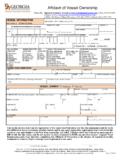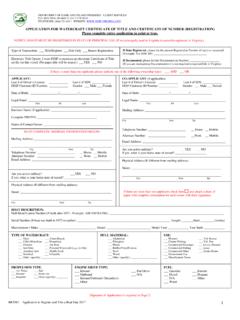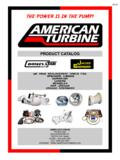Transcription of manually propelled boat. Like Other Sports! - …
1 2018 connecticut BOATERS GUIDE 6363 2014 connecticut BOATERS GUIDEI mportant Information for anyone using a kayak, canoe, stand up paddleboard or Other manually propelled boat . manually propelled boating activities ( rowing, stand up paddleboarding (SUP), canoeing and kayaking, etc.) are rapidly evolving. It seems that new styles of these boats and ways to enjoy them are appearing nearly every day. Boats such as pedal driven kayaks and inflat-able stand up paddleboards are attracting many new boaters and opening up new waters for many. Although these boats are attracting attention, traditional canoeing and kayaking activities are also gaining in , the increase number of manually propelled boaters has also increased the number of paddling relat-ed injuries and deaths. No formal education is required to use a manually propelled boat in connecticut . However, here are some rules that must be followed and good advice that will help keep your day on the water safe, more comfortable and fun from the start.
2 Take a lesson: Before venturing out on the water, consider taking a paddling course, the time and money you spend are well worth the investment! Knowing how to dress, the correct paddle strokes, the navigation rules, what equipment you should have with you on the water and how to use it, what to do in an emergency, being able to right and get back in your boat if you capsize are all skills that may lengthen your season and add to your boating enjoyment. Many of the paddling related acci-dents and deaths in connecticut might have been elimi-nated had the victims received some form of NOT paddle impaired: Do not drink alcohol or use drugs with serious side effects before or while paddling. These substances can reduce reaction time, balance, coordination, and judgment - all of which are vital to your survival in a threatening contact information on your boat : Attach an IF FOUND sticker to your unregistered boat or write the boat owners contact information in the boat .
3 This contact information can help rescuers locate you faster should an emergency situation occur and the boat is found unattended. (See page 43, for more information about If Found stickers.)Know your ability: Be honest with yourself when plan-ning a trip. Rough water, white water, or rapids can be difficult for experienced paddlers and are no place for beginners. Check the weather forecast, tides and water flows before heading out a location and for the period of time you plan to be on the water. Changes in weath-You need to have the right equipment and know the rules so that you can perform your , Is Like Other Sports! PADDLING AWARENESS64 2018 connecticut BOATERS GUIDEer, tides and water flows can easily turn a calm waterbody that is within your paddling abilities into a deadly environment. Our website contains links to a number of good connecticut weather forecasts and resources, ahead: Know the waters that you are pad-dling and plan your day accordingly.
4 Tell someone where you are going, what boat you are taking and when you plan on returning, this is called fil-ing a float plan. The information in a float plan will help first responders rescue you faster should an accident Paddling Alone: Paddle with a friend or group. You will have someone that can help you get back in your boat or call for help if appropriate clothing: The correct clothing choices can add significantly to your paddling comfort, extend your boating season and might save your life. Chose the most appropriate clothing you own. Dress in layers of clothing that will retain body heat when wet (fleece) and outer layers that repels water. Avoid cotton, which stays wet and does not retain heat. Wear a hat! (If you are a paddling in the cold water seasons consider investing in wet or drysuit, you will be amazed at the difference in comfort they make.)
5 WEAR A LIFE JACKET! The majority of paddlers that have died in connecticut were NOT wearing a life jacket. Sadly, if they had been, the outcome of these accidents could have been much differ-ent. connecticut law requires there be a properly fitting life jacket for everyone onboard a manually propelled vessel at all times. It also requires that, all children less than thirteen years of age at any time during the year and all adults between Oct 1 and May 31, wear a properly fitting life jacket while onboard a manually propelled vessel. Note: Stand-up paddleboards are considered ves-sels (boats) by the Coast Guard unless they are being used in a surf zone or designated swim area. Anyone who is using a stand-up paddle-board is required to abide by all boating a whistle to your life jacket: The sound of a whistle will travel farther than your voice and attract attention.
6 connecticut and federal laws require a sound producing device onboard all a communication device: Carry a phone in a waterproof bag and/or a marine VHF radio. In coastal/tidal waters a VHF radio (many handhelds are waterproof) is the best way to call for help. By using its modern VHF radio technology, the US Coast Guard can accurately pinpoint the location of a VHF radio transmission and send rescuers to that location faster than using traditional search-ing techniques. (Use VHF channel 16 to call the USCG. It is the international distress, safety and hailing channel.) Know the local regulations and navigation rules: Waterways are filled with all types of vessels engaged in many different activ-ities. Knowing and understanding the basic rules of the road will help make everyone s day on the water much safer and enjoyable. Please DO NOT paddle in the middle of main channels, high traffic areas or interfere with the passage of Other boat traffic.
7 Keep a lookout: Small paddlecraft can be difficult to see. Always keep an eye out for Other boats that are coming close to you. If possible, wear brightly colored clothes or use Other means to make you and your boat more visible on the water. Beware, that large boats DO NOT stop very quickly. Do your best to avoid putting yourself in a dangerous situation, larger boats may not be able to avoid a collision. PHOTO CREDIT- BOB DANEKPADDLING AWARENESS 2018 connecticut BOATERS GUIDE 65 BOATING ACCIDENT REPORT PREVIOUS EDITIONS ARE OBSOLETE Revised 9/2016 The operator of a vessel used for recreational purposes is required to file a report in writing within 48 hours whenever an accident results in loss of life, disappearance from a vessel or injury which requires medical attention beyond first aid. If total damage to all property is in excess of $500, a report must be filed within 5 days.
8 Reports shall be submitted to the commissioner of Energy and Environmental Protection at the above address. If the operator is unable to report the accident, the boat owner or survivor of the accident should prepare the report. Any person violating these requirements is subject to the penalties prescribed by BoatInflatable BoatAuxiliary SailCabin MotorboatOpen MotorboatHouseboatPWCR owboatSail ONLYO therPaddlecraftPontoon BoatFiberglassWoodSteelPlasticAluminumIn boardOutboardSterndrivePod DrivePropellerWater JetSailManualAir (Width) FROM TRANSOM TO DETAILSDATE OF ACCIDENTTIMEAMPM# VESSELS INVOLVEDNAME OF WATER BODYEXACT LOCATION If possible, provide Latitude and Longitude NEAREST TOWNWEATHER CONDITIONSC learCloudyFoggyOtherRainingHazySnowingWA VE CONDITIONSCalm (Under 6in.)Choppy (6in. - 2ft.)Rough (2ft. - 6ft.)Very Rough (over 6ft.)WINDNoneLight (0 - 12 mph)Moderate (12- 25 mph)Strong (25- 55 mph)Stormy (over 55 mph)VISIBILITYTIME OF DAYDayNightGoodFairPoorEST.
9 AIR TEMPEST. WATER TEMP F FSTRONG CURRENT?OPERATION AT TIME OF ACCIDENT (Check all applicable)Cruising (underway under power)Changing DirectionChanging SpeedDriftingAt AnchorBeing TowedSailingRacingRowing / PaddlingTied to Dock / MooringOther: (list)Towing Another VesselLaunchingDocking / UndockingFishingHuntingWaterskiing RelaxingWhite Water ActivityStarting EngineMaking RepairsCollision w/ Commercial VesselCollision w/ Floating ObjectFire / Explosion (Fuel)Collision w/Submerged ObjectFlooding / SwampingSinkingGroundingCapsizingPerson Struck By VesselFire / Explosion (Non- Fuel)Collision w/ Fixed ObjectPerson ElectrocutedCarbon Monoxide ExposurePerson Struck By PropellerPerson Fell OverboardPerson Fell On/Within VesselSudden Medical ConditionMishap of Skier, Tuber, wake brd Other (describe)Alcohol UseExcessive SpeedOperator InexperienceImproper AnchoringOperator InattentionImproper LoadingOverloadingImproper LookoutFailure to VentNavigation Rules ViolationDrug UseLanguage BarrierIgnition of Fuel or VaporsDam/LockForce of Wake/WaveHazardous WatersPeople on Gunwale/Bow/TransomHeavy WeatherHull FailureEquipment Failure (check applicable below)Starting in GearSharp TurnRestricted Vision (ex.)
10 , fog)Missing/Inadequate Aids to On-Board Nav. LightsOther (describe)SAFETY EQUIPMENT ON VESSELN umber of Life Jackets Onboard:YesNoWere They USCG approved?YesNoWere They Used?YesNoWere They Accessible?Number of Fire Extinguishers and Type:YesNoWere They Used?PERSONAL FLOTATION DEVICESFIRE EXTINGUISHERSHAS VESSEL HAD A VESSEL SAFETY CHECK WITHIN THE PAST YEAR?ORGANIZATION THAT CONDUCTED THE VESSEL SAFETY CHECKYesNoUSCG AuxiliaryUS Power SquadronsDEEPO therYesNoGiven A VSC Sticker?NAME AND ADDRESS OF 'S PHONE NUMBEROPERATOR'S SAFE BOATING OR PWC CERTIFICATE #OPERATOR'S EXPERIENCE ON THIS VESSELU nder 20 hours20 to 100 hours100 to 500 hoursOver 500 hoursOPERATOR'S EXPERIENCE ON Other VESSELSOPERATOR'S FORMAL BOATING INSTRUCTION (Check all that apply)US Power SquadronsUSCG Aux. CourseState CourseNoneGENDERNAME AND ADDRESS OF OWNERRENTED boat ?NUMBER OF PEOPLE ON BOARDNUMBER OF PEOPLE BEING TOWED ex.
















